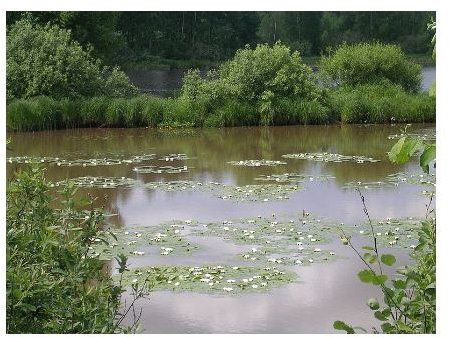The Ecology Ecosystem of a Pond System: Learn more about the Organisms, Habitats and Food Chain of Pond Ecology
A pond
ecosystem is a complex interdependent system of plants, animals and microorganisms along with the physical environment in which they live. Pond ecology depends first and foremost on the freshwater environment for nutrients and survival.
Ponds are usually shallow, which allows sunlight to reach organisms growing on the bottom. A freshwater pond ecosystem consists of a four habitats, populated by three types of organisms that live in four different habitats. Every element of a pond ecosystem works in conjunction with the others to maintain balance.
Organisms in a Pond Ecosystem
Fishes, plants, algae, fungi, and microorganisms in the pond ecology fall into three categories:
- Producers - those that provide or are food for other species.
- Consumers - those that partake of the food provided by Producers.
- Decomposers - those that decompose and consume dead organisms
Habitats in the Pond Ecology Ecosystem
A habitat is a structure or environment which provides the needed elements for the life of an organism. A pond is made up of four interdependent habitats:
- Shore Habitat - The organisms that inhabit the shore habitat are dependent upon what kind of shoreline exists. Some shorelines may not be conducive to plant growth, where others may contain all four of the predominant pond ecosystem organisms.
- Surface Film - Insects such as water striders and other organisms able to walk or float on the surface inhabit the surface of the pond ecosystem. They feed on the floating plants, dead insects and even each other when need arises.
- Open Water - Fishes and plankton inhabit this third habitat of the pond. Phytoplankton (algae) and zooplankton (insect larvae, invertebrates, rotifier, and tiny crustaceans) are present as well.
- Bottom Water - Bottom habitat varies according to the depth of the pond. Shallow ponds with sandy bottoms may contain insects, earthworms, and snails. A deep pond with a muddy bottom will contain dragonfly nymphs, microorganisms, maggots, and flatworms.
The Pond Ecosystem Food Chain
In order to live, all organisms must eat. A food chain is a hierarchical system of consumption. There are three basic levels in the food chain of a pond.
- Producers or autotrophs: Made up of phytoplankton and plants, these organisms use sunlight and photosynthesis to create their own food.
- Herbivores: Insects, invertebrates and crustaceans which consume the plants.
- Carnivores: Fishes and other organisms which can feed on both plants and herbivores.
The decomposers, or sapotrophs, are at the very bottom of the food chain. Mostly comprised of fungi and bacteria, these organisms are vital to the nutrient cycle, as they convert all dead organic matter into carbon dioxide and nutrients that can be readily use by algae and plants to produce food.
Maintaining a Pond Ecosystem
When a pond ecology ecosystem is in balance, you have healthy plants and fit fish. When that balance is disrupted, you have a murky, unhealthy mess. Learning as much as you can about how to maintain your pond is the only way to assure a clear, beautiful pond that operates well on all levels, and supports all its elements.
Whether natural or man made, a pond is something that has to be watched over and kept up to assure that it, and the creatures that inhabit it, stay as healthy and disease free as possible.
Photo credit: Burger / Wikimedia Commons
